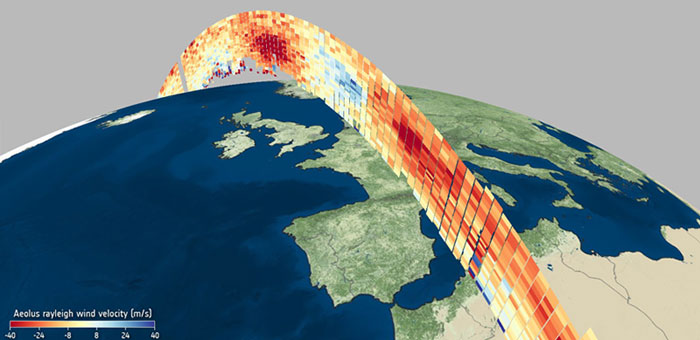- News
- Aeolus data now publicly avail...
Aeolus data now publicly available
19 May 2020
Last week marked an exciting milestone for ESA's wind mission, Earth Explorer Aeolus. On 12 May, its wind data, previously accessible only to expert user groups involved in validation activities, became publicly available.
Aeolus is the first satellite mission to acquire profiles of Earth's wind on a global scale. Launched on 22 August 2018, it has already been hailed a success. Its near-real time observations have been shown to improve the accuracy of numerical weather prediction (NWP) models and its data have been recently used in efforts to fill in the gap in meteorological data, created by the grounding of aircrafts during the COVID-19 pandemic. Scientists have also begun to use the data to study tropical dynamics and processes relevant to climate variability.
The public data release will now make Aeolus wind data available for forecast centres and scientists around the world. The release was made possible due to the optimisation work performed by the experts of the Aeolus Data Innovation and Science Cluster (Aeolus DISC), and a global team of independent validation experts.

Following the introduction in June 2019 of a correction of biases related to spectrometer pixels showing elevated dark current levels, the telescope mirror temperature-based bias correction was the last and largest missing puzzle piece needed to assure near-real time production of low bias wind data.
Discovered in September 2019 by Aeolus DISC experts, the mirror temperature-based bias is due to small variations in the temperature distribution across the large mirror (M1) of the Aeolus instrument's telescope, which is tracked by temperature sensors as part of housekeeping data.
Prior to assimilating Aeolus data to their NWP models in January 2020, the European Centre for Medium-Range Weather Forecasts (ECMWF) developed its own internal bias correction scheme based on the statistical comparison of Aeolus data to their own wind models. Several other forecast centres involved in validation activities also confirmed the positive impact of the correction in offline experiments.
ESA's own correction for the bias was successfully introduced and implemented in operational processors on 20 April 2020, leading to a reduction of biases to around 1m/s, making Aeolus' wind data ready to be used for assimilation into NWP models and for scientific exploitation.
These new data are being distributed in near real-time through ESA's Aeolus Online Dissemination System as well as other channels, namely EUMETCast, which is the European Organisation for the Exploitation of Meteorological Satellites' (EUMETSAT's) dissemination system, and the World Meteorological Organization's Global Telecommunication System (GTS).